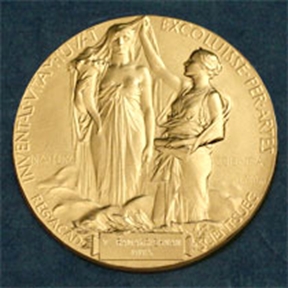Lighting – The 2014 Nobel Prize in Physics was awarded on October 7, 2014 “for the invention of efficient blue light-emitting diodes which has enabled bright and energy-saving white light sources”. The prize was awarded to Isamu Akasaki, Meijo University, Nagoya, Japan and Nagoya University, Japan, Hiroshi Amano, Nagoya University, Japan, and Shuji Nakamura, University of California, Santa Barbara, CA, USA.

Source: Nobelprize.org
The Royal Swedish Academy of Sciences stated: “When Isamu Akasaki, Hiroshi Amano and Shuji Nakamura produced bright blue light beams from their semi-conductors in the early 1990s, they triggered a fundamental transformation of lighting technology. Red and green diodes had been around for a long time but without blue light, white lamps could not be created. Despite considerable efforts, both in the scientific community and in industry, the blue LED had remained a challenge for three decades. They succeeded where everyone else had failed. Akasaki worked together with Amano at the University of Nagoya, while Nakamura was employed at Nichia Chemicals, a small company in Tokushima. Their inventions were revolutionary. Incandescent light bulbs lit the 20th century; the 21st century will be lit by LED lamps.”
Nearly all of today’s liquid crystal displays (LCDs) employ LEDs to implement the back lighting source. That’s a lot of LEDs. Large format displays consisting of individual red, green and blue (RGB) LEDs are widely deployed as outdoor displays in sports venues and as video walls as I wrote recently. Again, that’s a lot of LEDs. Smartphones with LED backlit LCDs also sport white LEDs that serve as camera flash sources and double as convenient LED flashlights. LEDs are also rapidly evolving as market leading light sources for general, automotive and specialty illumination. All in all, that certainly is a lot of LEDs.
In the run-up to the award of the 2014 Nobel Prize for Chemistry on October 8, 2014, there were press reports that the prize might be awarded to Ching W. Tang and Steven Van Slyke for their work on organic light emitting diodes (OLEDs) conducted in the 1980’s and 1990’s at Kodak in Rochester, New York. On October 8, we found that Tang and Van Slyke did not win a Nobel Prize. Perhaps two LED-related Nobel Prizes in a single year was not considered appropriate. Or perhaps, another decade or two will pass before OLEDs will be viewed as having as great an impact as has the inorganic LED. Today’s outstanding OLED display smartphones and flat panel televisions as well as advancing efforts to develop efficient and cost effective OLED lighting certainly would indicate that, and an OLED-based Nobel may be something to look forward to in the future.
As noted by the Nobel committee, LEDs had been around for a good number of years before the Physics Prize honorees did their work during the 1980’s and 1990’s. The red LED and semiconductor laser were first demonstrated in 1962 by Nick Holonyak, Jr. a member of the Semiconductor Products Department at General Electric in Syracuse New York. Since the invention of the red visible light LED in the early 1960’s, many researchers worked to extend the range of emission wavelengths and their corresponding colors from orange, to yellow and to green. However, practical and efficient blue light emitters were much slower to develop. The 2014 Nobel Prize awardees were diligent in their efforts to understand and obtain efficient light emission from improved quality gallium nitride semiconductor material. Their effort in the 1980’s and 1990’s led directly to the widespread use and acceptance of gallium nitride-based LEDs for solid state white light illumination. However, their efforts benefited greatly from the efforts of prior researchers like Nick Holonyak and others who also foresaw the benefits and advantages of solid state lighting. – Phil Wright

